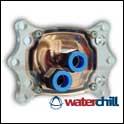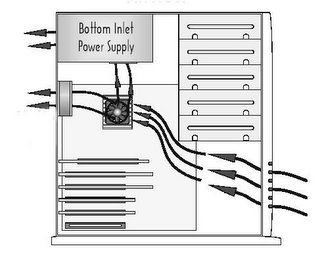ElectriPlast, A Material to Cool Computer Processors...

Much as been said about the potential of ElectriPlast, a plastic material that can conduct electricity as well as metal.
A plastic material that tests prove to be a most adroit antenna, capable of picking up radio emissions (signals) better than any other antenna product presently on the market.
Though, to date, I have dwelled on these and a few other significant aspects, I have yet to expand the notion of why ElectriPlast is referred to as a disruptive material.
Rather than leave the readers guessing at what was gleaned from the patents already submitted and which are public record, let's get to the heart of it. Like that block of plastic advertised in commercials a number of years back--the one that helped to speed the defrosting of frozen meats--ElectriPlast does one better. With varying doping processes of Tom Aisenbrey's IP ElectriPlast formula, many properties can be achieved. One unique process is used to create a plastic formula that can also be used to dissipate heat.
You might think, ok, a plastic material that can be used to cool--on a hot summer day, I'll now go out and buy a bodysuit of the stuff and cancel the new swimming pool planned for the backyard.
Though a nice thought, more to the point is the notion of which could best benefit from such a low cost, low tech feature?
Real world example time: I am typing on a computer that is extremely old, by today's standards. Though I am making no other noise, aside from the tapping of my keyboard, I hear raging at my feet the sound of a fan working hard to keep my computer's 386 processor from greeting me with the blue screen of death.
Mine is an old computer. New computers rely dearly on the transfer and dispersal of heat in order to maintain the speeds, power and capabilities users today enjoy as commonplace.
Imagine if you will, what would happen if one of the many computer, or chip processor companies took notice of ElectriPlast's unique heat dispersal abilities?
Better yet, imagine if they put this ElectriPlast heat dispersing material to a test, comparing it on a head-to-head basis with many of the other various systems on the market, and as a result, found Integral's ElectriPlast a solid, less expensive contender with those proven computer processor cooling systems...
Take a moment to read the article below, and sense this particular potential for yourself...
-------------------------------
Internet & Technology
HP's Burning Question: How To Keep Systems Cool
By: Ken Spencer Brown -- Investor's Business Daily -- Posted: 3/2/2006
Having a hot new product isn't always a good thing.
Just ask Hewlett-Packard.
The company's server computers are too hot -- literally. After years of racing to make the systems as fast as possible, the Palo Alto, Calif., company is scrambling to cool down its machines.
Today's faster chips consume more electricity, and most of that ends up as heat energy. Five years ago, a typical server setup drew about 50 watts of electricity. Today, 250 watts are the norm.
That's not a big deal with a personal computer, where a fan or two can send enough cool air to prevent overheating. But when lots and lots of chips are packed into small spaces -- the situation in most data centers -- the problem multiplies quickly. There's only so much air a cooling system can pump in. And air conditioning gets expensive fast.
"It's reached critical mass," said Paul Perez, who heads the storage, networking and infrastructure businesses for HP's (HPQ) server group.
Hoping to get a handle on the problem, HP has launched a line of gear designed to prevent data center meltdowns:
- HP's Modular Cooling System acts as a sort of radiator for servers. It pumps chilled water to the server's framing, called a rack, to cool machines directly.
- The firm's 10000 G2 Series Rack uses standard air cooling, but improves ventilation.
- HP Power Distribution Unit Management Module lets techies more closely watch over the power usage -- and thus heat -- of a data center.
Eventually, companies could shift horsepower to other data centers around the globe to take advantage of cooler weather or electricity costs. A user could fire up systems in Serbia during the day and switch to systems in Arizona at night.
HP's rivals are dealing with the heat issue in different ways.
 IBM (IBM) last year launched a water-cooling system called the Rear Door Heat exchanger and is looking at simple design changes to its server's chassis to better circulate air.
IBM (IBM) last year launched a water-cooling system called the Rear Door Heat exchanger and is looking at simple design changes to its server's chassis to better circulate air.Sun Microsystems (SUNW) is tackling the problem at its source with its T1 line of processors, formerly known as Niagara. Using just 70 watts of electricity, the systems run much cooler than similarly powered machines.
That also brings an environmental benefit, says Scott McNealy, Sun's chief executive. "We have a cause: eliminating the digital divide without torching the planet," he said at a recent Sun event.

Rackable Systems, (RACK) whose stock has exploded since it went public last summer, has long focused on cooler running systems. It uses a patented chassis design that circulates air more efficiently inside the machines.
And some of its systems perform the standard AC/DC conversion in a centralized fashion, rather than inside each server. Though some dispute the logic, Rackable officials say that makes cooling easier.
The firm also makes sure customers aren't converting more power than they need -- a big source of needless heat.
When IBM launched its water-cooling systems last summer, Rackable executives slammed such systems as risky and expensive.
"We're skeptical," said Josh Goldenhar, Rackable's marketing director.








0 Comments:
Post a Comment
<< Home